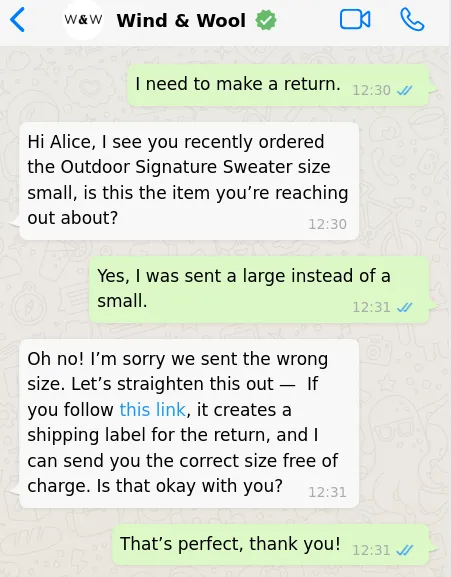
Clientes
A revolução da personalização no atendimento ao cliente
27 de janeiro de 2023
Para os consumidores, as interações que ocorrem durante o atendimento ao cliente muitas vezes são frustrantes. No entanto, com o atual foco na experiência proativa do cliente, os problemas dele, bem como o estresse que vem junto, são apenas um dos pontos de contato em seu serviço de atendimento ao consumidor. A personalização dá à sua empresa a capacidade de oferecer aos clientes não apenas as soluções de que precisam, mas também uma experiência sob medida ideal para eles. Os dados coletados de interações anteriores podem ajudar a prever e atender as necessidades e os desejos dos clientes de uma maneira simples e pessoal.
Benefícios das mensagens personalizadas para os clientes
Sentem-se valorizados
52% dos consumidores pressupõem que todas as mensagens recebidas das marcas são personalizadas.2 Quando procuram sua empresa para pedir ajuda, os clientes esperam que ela já saiba quem eles são e o que é importante para eles. E quem pode culpá-los por isso? Receber um tratamento individualizado e se sentir valorizado é mais atrativo do que ser só mais uma solicitação de atendimento. O suporte personalizado pode causar um impacto positivo duradouro em um cliente e ajudar a gerar fidelidade. Se o seu atendimento ao cliente não faz com que ele se sinta valorizado, você corre o risco de perdê-lo.
Obtêm soluções personalizadas
As soluções personalizadas podem ajudar a criar a experiência ideal de atendimento ao cliente usando os dados que ele já forneceu voluntariamente. Isso significa que interações como oferecer reembolsos, retomar interações anteriores e entender o que o cliente está buscando muitas vezes podem ser conduzidas por chatbots. Esses assistentes com IA têm acesso imediato a todas as informações do cliente, permitindo que eles ofereçam personalização em todas as situações.
Quando e onde usar a personalização
Embora os clientes queiram uma experiência personalizada, eles não querem que a empresa estrague tudo. Quando um cliente tem um problema, tratá-lo como alguém importante para sua empresa pode transformar essa insatisfação em uma experiência positiva. Mas, se você não entender direito o problema dele, só vai complicar ainda mais a interação.
Dito isso, assumir a responsabilidade por um erro é uma grande oportunidade de personalizar suas mensagens. Segundo um estudo recente da Zendesk, 50% dos consumidores trocam de marca após uma experiência ruim, e 80% trocam de marca após mais de uma experiência ruim..5 Reconhecer onde as coisas deram errado e garantir que o cliente tenha a necessidade dele atendida podem ser fatores cruciais para mantê-lo como consumidor.

Melhores práticas para as mensagens personalizadas
Valor agregado
Embora a personalização seja importante, ela não vai adiantar nada se você não resolver os problemas dos consumidores. O objetivo do atendimento ao cliente, seja ele reativo ou proativo, é oferecer soluções. Portanto, é necessário que a personalização ajude a fornecer uma boa solução. Uma ótima resposta personalizada para o problema do cliente pode elevar muito a satisfação dele com a empresa.
Chamada para ação (CTA)
Toda conversa é uma oportunidade. Isso significa que, mesmo no atendimento ao cliente, suas conversas devem terminar chamando a atenção dele. Seja fornecendo informações adicionais, sugerindo produtos relacionados ou pedindo um feedback, uma CTA personalizada torna as interações de atendimento mais valiosas. Na verdade, a HubSpot constatou que as chamadas para ação personalizadas têm um desempenho 202% melhor que o das CTAs genéricas.6
Momento certo
O atendimento proativo ao cliente é extremamente importante, e saber quando e onde oferecê-lo é essencial. Logo após uma compra ser feita? É um ótimo momento. Às 6h da manhã quando você não fala com o cliente há meses? Talvez não seja uma boa hora.
Entender quando e como seus clientes podem precisar de ajuda personaliza ainda mais a experiência de atendimento, ajudando a gerar impressões positivas. Alertar os clientes sobre atrasos, enviar informações relevantes do produto e criar ofertas personalizadas são apenas algumas formas de oferecer atendimento personalizado e proativo ao cliente.
Opções para o cliente
Embora o atendimento proativo seja uma excelente forma de manter sua base de clientes, existem regras a cumprir. A aceitação do consumidor é obrigatória para o envio de mensagens comerciais ou promocionais. Além disso, as solicitações de permissão ajudam a garantir que você alcance os clientes mais interessados na sua empresa. Eles expressaram que querem se comunicar com você, e as conversas personalizadas são o modo perfeito de aproveitar esse interesse.

O avanço da personalização
A personalização está se tornando um dos pilares das interações B2C. Mas os riscos de fazer isso da forma errada são reais, o que levou algumas empresas a hesitar em adotar a personalização, especialmente nas interações de atendimento ao cliente. No entanto, em vez de ser um bloqueio, a personalização pode ajudar seu atendimento a agradar e conquistar clientes insatisfeitos. Um serviço cordial e individualizado é o caminho a seguir, e sua empresa pode estar a apenas alguns passos de elevar a experiência de atendimento ao cliente.
Quer saber mais sobre o atendimento ao cliente com a Plataforma do WhatsApp Business? Confira estes recursos relacionados:
